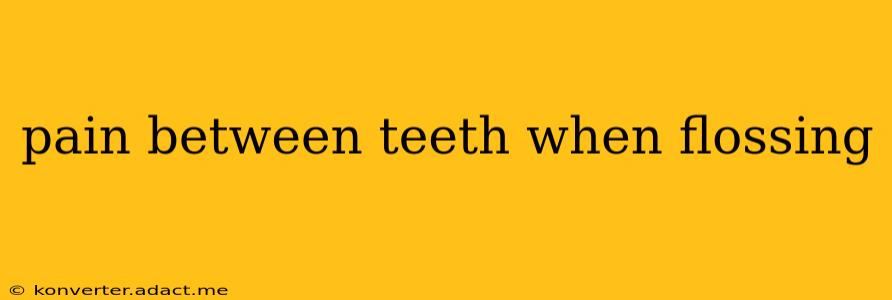Flossing is crucial for maintaining good oral hygiene, but experiencing pain while flossing can be a frustrating and concerning experience. This pain, often felt between the teeth, can stem from various causes, ranging from simple gum irritation to more serious underlying dental issues. Understanding the potential reasons behind this discomfort is the first step towards finding relief and maintaining a healthy mouth.
Why Does It Hurt When I Floss?
This is the most common question people ask when they experience this type of discomfort. The answer, however, isn't always straightforward. Several factors could be contributing to your pain:
1. Gingivitis (Gum Inflammation):
Gingivitis, the early stage of gum disease, is a prevalent cause of flossing pain. Inflamed gums are highly sensitive and bleed easily, making flossing an uncomfortable experience. The inflammation often results from plaque buildup along the gum line, irritating the delicate gum tissue.
2. Periodontitis (Gum Disease):
More advanced gum disease, periodontitis, can also cause significant pain when flossing. In periodontitis, the infection extends beyond the gums, affecting the supporting structures of the teeth. This can lead to deeper pockets between the teeth, making flossing difficult and painful.
3. Receding Gums:
Receding gums expose the sensitive root surfaces of the teeth, making them vulnerable and painful to floss. This recession can be a consequence of aggressive brushing, gum disease, or genetics.
4. Improper Flossing Technique:
Using too much force or employing an incorrect flossing technique can cause significant gum trauma and pain. Snapping the floss between teeth or sawing it back and forth can damage delicate gum tissue.
5. Food Impaction:
Food particles wedged between teeth can irritate the gums and make flossing uncomfortable. These particles can contribute to inflammation and make it more challenging to clean the area effectively.
6. Recent Dental Work:
Pain during flossing may be a normal reaction after dental procedures such as extractions, fillings, or deep cleanings. The gums might be tender and sensitive in the immediate post-operative period.
What Can I Do to Reduce Flossing Pain?
If you're experiencing pain when flossing, it's crucial to address the underlying cause and adjust your technique:
1. Gentle Flossing Technique:
Use a gentle “C” shape around the tooth, carefully sliding the floss between your teeth, avoiding snapping or sawing motions. Use a new section of floss for each tooth to ensure cleanliness and prevent the transfer of bacteria.
2. Use Floss Picks:
Floss picks can offer a more comfortable grip and help you control the tension on the floss, reducing the risk of injury.
3. Therapeutic Mouthwash:
Using a therapeutic mouthwash can help reduce inflammation and soothe irritated gums. Look for mouthwashes containing chlorhexidine or essential oils.
4. Regular Dental Checkups:
Regular visits to your dentist are crucial for early detection and treatment of gum disease. They can identify and address any underlying issues causing your flossing pain.
5. Gradual Flossing:
If the pain is severe, try flossing only a few teeth at a time, gradually increasing the number as your gums become more comfortable.
6. Consider Water Flossers:
Water flossers, also known as oral irrigators, offer a gentler alternative to traditional flossing for individuals with sensitive gums.
When to See a Dentist
Persistent pain, bleeding gums, or swelling despite home care warrants an immediate visit to your dentist. These could indicate more serious underlying dental issues that require professional intervention. Ignoring these symptoms could lead to complications like advanced gum disease or tooth loss. Don't delay seeking professional dental care if your flossing pain is accompanied by other symptoms.
This article is for informational purposes only and does not constitute medical advice. Always consult with a qualified dental professional for any concerns regarding your oral health.
